Flak tower

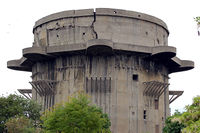
Flak towers (German: Flaktürme) were 8 complexes of large, above-ground, anti-aircraft gun blockhouse towers constructed in the cities of Berlin (3), Hamburg (2), and Vienna (3) from 1940 onwards. They were used by the Luftwaffe to defend against Allied air raids on these cities during World War II. They also served as air-raid shelters for tens of thousands of people and to coordinate air defence.
History and uses
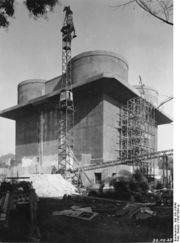
After the RAF's raid on Berlin in 1940, Adolf Hitler ordered the construction of 3 massive flak towers to defend the capital from air attack. These towers were each supported by a radar installation that had a retractable radar dish (the dish would be retracted behind a thick concrete and steel dome in order to prevent damage in an air raid). The flak towers, the design of which Hitler took personal interest in and even made some sketches for, were constructed in a mere 6 months. The priority of the project was evidenced in the fact that the German national rail schedule was altered in order to facilitate the shipment of the necessary materials, namely concrete, steel and lumber to the construction sites.[1]
With concrete walls up to 3.5 metres thick, flak towers were considered to be invulnerable to attack with the usual ordnance carried by Allied bombers, though it is unlikely that they would have withstood Grand Slam bombs which successfully penetrated much thicker reinforced concrete. Aircraft generally appeared to have avoided the flak towers. The towers were able to sustain a rate of fire of 8000 rounds per minute from their multi-level guns, with a range of up to 14 km in a full 360-degree field of fire. The 3 flak towers around the outskirts of Berlin created a triangle of formidable anti-aircraft fire that covered the centre of Berlin.
The flak towers had also been designed with the idea of using the above-ground bunkers as a civilian shelter, with room for 10,000 civilians, and even a hospital ward, inside. The towers, during the fall of Berlin, formed their own communities, with up to 30,000 or more Berliners taking refuge in a single tower during the battle. These towers, much like the keeps of medieval castles, were some of the safest places to be in a fought-over city, and so the flak towers were some of the last places to surrender to Allied forces, eventually forced to capitulate as supplies ran out[2].
The Soviets, in their assault on Berlin, found it difficult to inflict significant damage on the flak towers, even with some of the largest Soviet guns, such as the 203 mm howitzers. Soviet forces generally manoeuvered around the towers, and eventually sent in envoys to seek their submission. Unlike much of Berlin, the towers tended to be fully stocked with ammunition and supplies, and the gunners even used their anti-aircraft 20 mm cannons to defend against assault by ground units. The Zoo Tower was one of the last points of defence, with German armoured units rallying near it at Tiergarten, before trying to break out of the encircling Soviet Red Army.
For a time after the war, the conversion to representative objects with decorated facades was planned. After the war was lost, the demolition of the towers was in most cases unfeasible and many remain to this day.
Flak tower design iterations

Each flak tower complex consisted of:
- a G-Tower (German: Gefechtsturm) or Combat Tower, also known as the Gun Tower, Battery Tower or Large Flak Tower, and
- a L-Tower (German: Leitturm) or Lead Tower also known as the Fire-control tower, command tower, listening bunker or small flak tower.
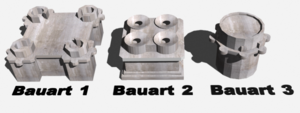
- Generation 1
- G-Towers were 70.5 × 70.5 × 39 m, usually armed with eight (four twin) 128 mm guns and numerous 37 mm and thirty-two (eight quad) 20 mm guns.
- L-Towers were 50 × 23 × 39 m, usually armed with sixteen (four quad) 20 mm guns.
- Generation 2
- G-Towers were 57 × 57 × 41.6 m, usually armed with eight (four twin) 128 mm guns and sixteen (four quad) 20 mm guns.
- L-Towers were 50 × 23 × 44 m, usually armed with forty (ten quad) 20 mm guns.
- Generation 3
- G-Towers were 43 × 43 × 54 m, usually armed with eight (four twin) 128 mm guns and thirty-two (eight quad) 20 mm guns.
The evaluation of even larger Battery Towers was commissioned by Adolf Hitler. These would have been three times the size and firepower of flak towers.
Towers
Flakturm I - Berliner Zoo, Berlin
- Berlin Zoo (1st Generation)
- G-Tower was demolished by the British at the end of the war.
- L-Tower was demolished after the war.
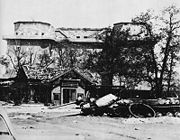 Zoo Tower, Berlin, after the battle |
 Flak position on the Zoo Tower |
Flakturm II - Friedrichshain, Berlin
- Friedrichshain (1st Generation)
- G-Tower was partially demolished after the war; one side remains visible.
- L-Tower was demolished after the war.
The G-Tower, known as Mont Klamott (Rubble Mountain) in Berlin, was the inspiration for songs by singer-songwriter Wolf Biermann and the rock band Silly.
Flakturm III - Humboldthain, Berlin
- Humboldthain (1st Generation)
- G-Tower was partially demolished after the war; one side remains visible. The interior can be visited.
- L-Tower was partially demolished after the war; some walls remain visible.
 Flakturm II G-Tower |
Flakturm IV - Heiligengeistfeld, Hamburg
- Heiligengeistfeld (1st Generation)
- G-Tower was transformed into a nightclub with a music school and music shops. .
- L-Tower was demolished after the war and ironically replaced by a very similar looking building by T-Mobile. .
 Flakturm IV G-Tower |
Flakturm V - Wilhelmsburg, Hamburg
- Wilhelmsburg (2nd Generation)
- G-Tower remains to this day,
- L-Tower was demolished after the war.
 Flakturm V G-Tower |
Flakturm VI - Stiftskaserne, Vienna
- Stiftskaserne (3rd Generation)
- G-Tower is being used by the Austrian Army.
- L-Tower (in Esterhazypark) is used as a public aquarium, the Haus des Meeres, since 1957.
|
Flakturm VI G-Tower |
 Flakturm VI L-Tower |
View from the climbing wall |
Flakturm VII - Augarten, Vienna
- Augarten (3rd Generation)
- G-Tower remains empty. The entire north-east and half of the east 20 mm gun platforms have been removed during 2007 including the connecting walkways due to deterioration. The tower itself has been reinforced with steel cables encircling the entire structure, 12 cables are located above the gun nests, 6 just below, and an additional 4 midway up the tower. The tower is home to thousands of pigeons which nest on every platform and opening. The west side of the structure is also used as a cellular communications tower.
- L-Tower remains empty. Its use as a computer storage facility or an open air cinema is being considered.
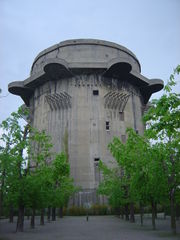 Flakturm VII G-tower |
 Flakturm VII L-tower |
Flakturm VIII - Arenberg Park, Vienna
- Arenberg Park (2nd Generation)
- G-Tower is used as a storehouse for art.
- L-Tower remains empty.
 Flakturm VIII G-tower |
 Flakturm VIII L-tower |
Planned towers (not built)
Berlin
- Tiergarten (two additional planned, not built)
- Hasenheide Templehof (planned, not built)
- Reichstag building (considered for modification, but found unsuitable)
Bremen
- Bremen Neustadt Contrescarpe (two planned, none built)
Hamburg
- East Hamburg (planned, not built)
Munich
- Munich Railroad Station (eight planned, none built)
Vienna
- Original plans were to place the three towers in Schmelz, Prater & Floridsdorf.
Flak guns
- 37mm Flak 43
- 2 cm Gebirgsflak 38
- 12.8 cm Flak 40
See also
- Anti-aircraft warfare
- Battle of Berlin (air)
- Battle of Berlin
- Kammhuber Line
- List of World War II weapons of Germany
- Nazi architecture
Further reading
- Foedrowitz, Michael. (1998). The Flak Towers in Berlin, Hamburg and Vienna 1940-1950. Schiffer Publishing. ISBN 0-7643-0398-8
- Ute Bauer "Die Wiener Flakturme im Spiegel Oesterreichischer Erinnerungskultur", Phoibos Verlag, Wien 2003. ISBN 3-901232-42-7
Notes
- ↑ George Pagliero. (2008). Hitler's Secret Bunkers. [Documentary]. United Kingdom: Fulcrum TV. http://www.imdb.com/title/tt1262365/.
- ↑ Beevor, Antony (April 2009). Berlin:The Downfall.
External links
- Several photos of the towers and bunkers (German)
- List of books about flak towers and bunkers (German)
- Page about the Vienna flak towers (German)
- What remains of the flaktowers today
|
|||||||||||||||||